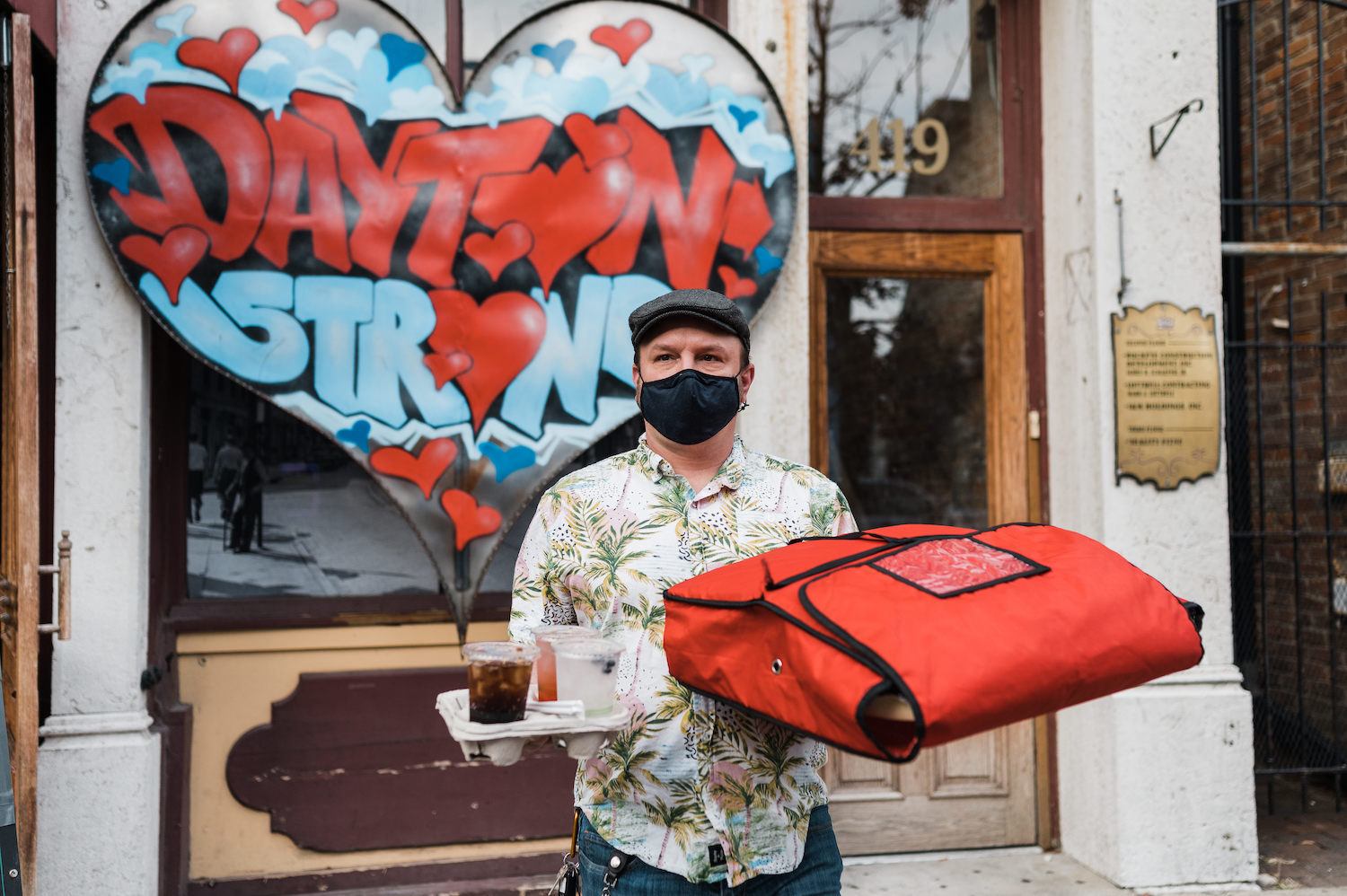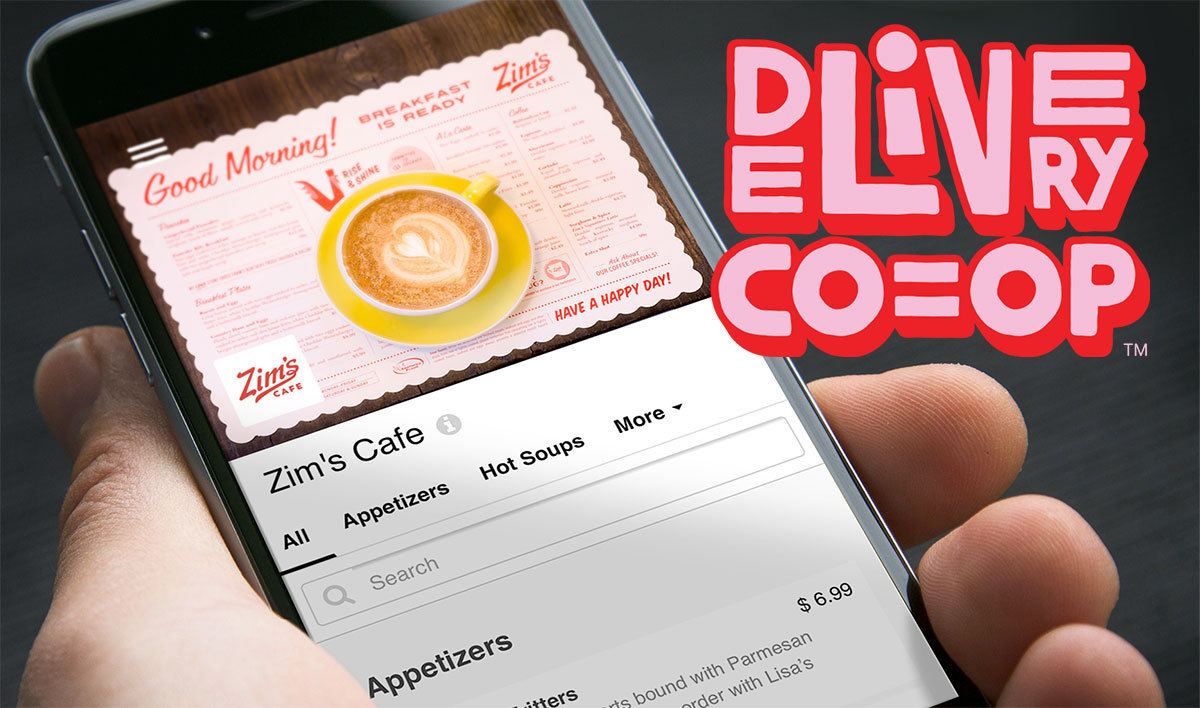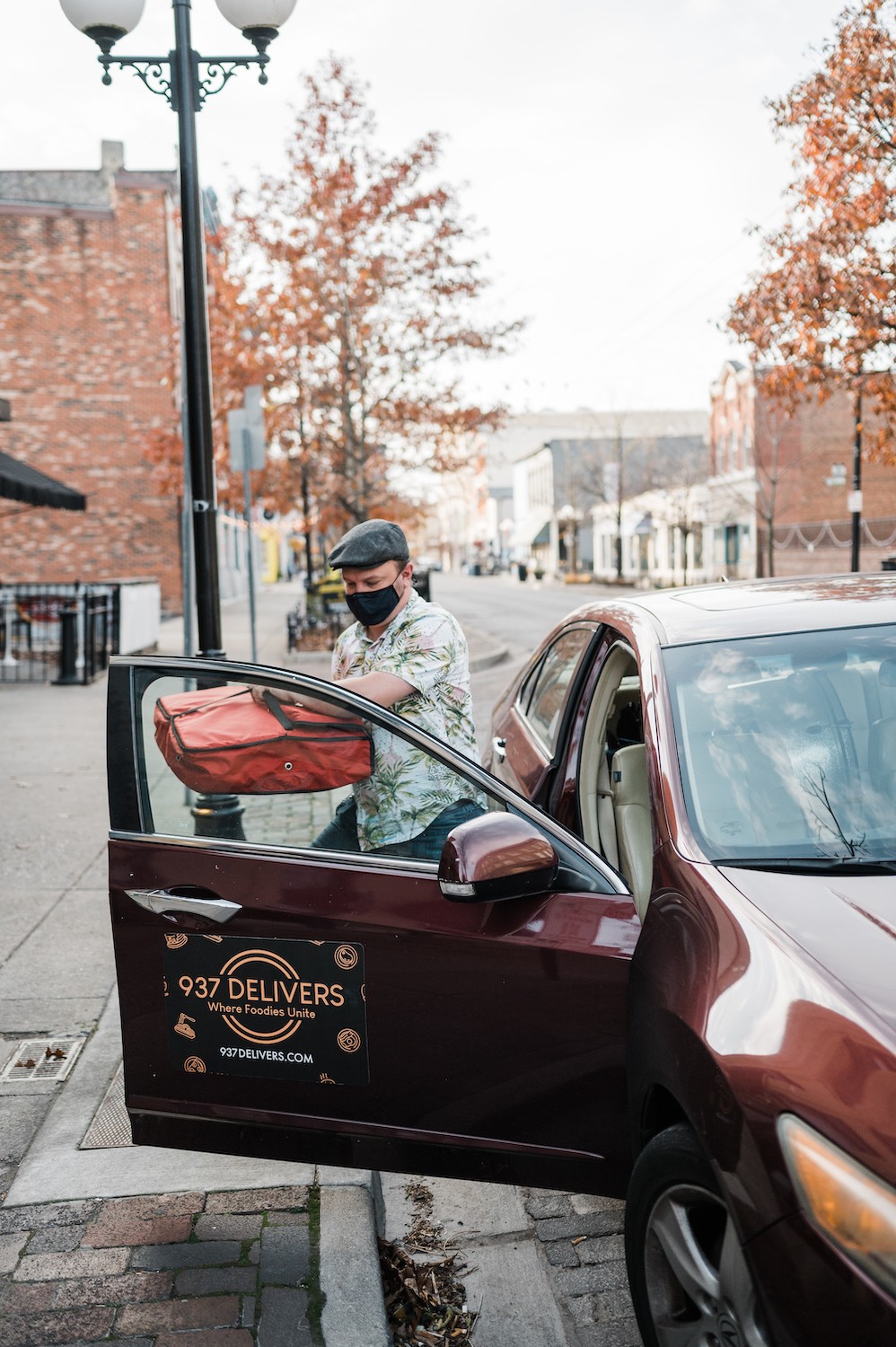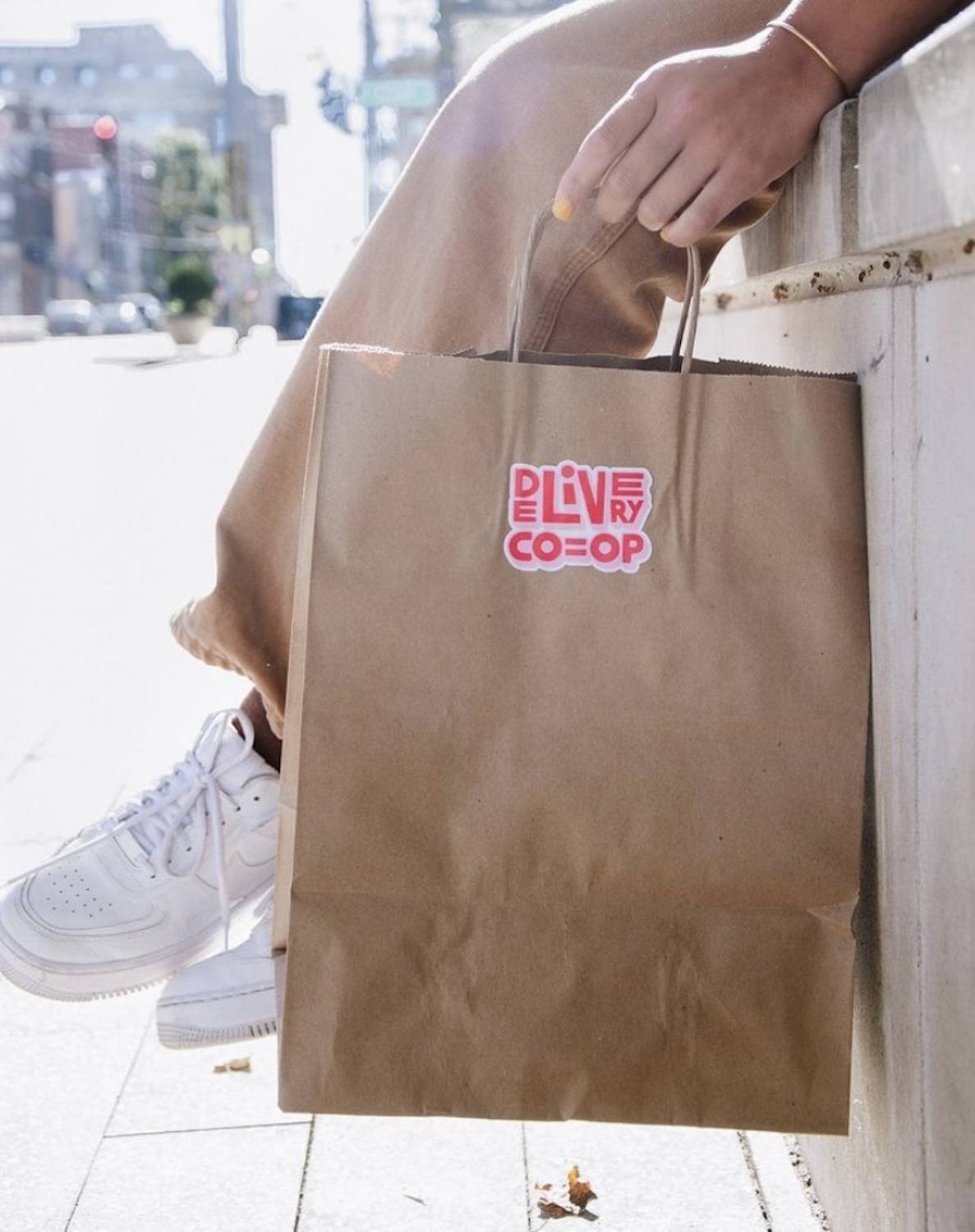How Much Do Restaurant Delivery Services Charge

Chelsea Hall
The Grubhub model is hither to stay. Only community-based delivery services could be lifelines for pocket-size restaurants contesting huge commission fees.
During the pandemic, homebound Americans more than doubled their food delivery orders, largely through third-party apps like Seamless and UberEats. Covid-nineteen lockdowns may take hastened the apps' growth, but economists have tracked a dramatic uptick in the employ of such platforms over the past five years.
Simply the convenience of these apps masks an inherently predatory nature, with crippling fees and dubious business practices that afflict restaurants and delivery drivers. Commission fees can account for about 15 to thirty percent of an lodge'due south sales, and major companies including Grubhub have been sued for declared sneaky practices to ramp upwards fees. Commitment drivers—who are considered independent contractors—oft earn depression wages for minimal protections from the companies. Reports have revealed creatively devised schemes, like Grubhub building fake eatery websites, or DoorDash delivering knockoff food from ghost kitchens.
In this fraught environs, some restaurants are fighting dorsum.
Owners and workers across the country, from Ohio to Nebraska to Washington, D.C., are now pooling their resource to launch culling delivery models in their ain communities that could potentially compete with the large apps. Many take emerged as cooperatives, where the eateries pay membership fees to fund operating costs and driver and dispatcher salaries. They in turn receive ownership responsibilities and a yearly share of profits.

At Delivery Co-op, eight restaurants pay $300 per month to participate, while around 400 customers pay $25 a month to employ the delivery service with no extra fees.
David Coomer
Restaurant veterans in Lexington, Kentucky, for example, established a subscription-based model in summer 2020 with Delivery Co-op. Currently, 8 restaurants pay $300 per month to participate, while around 400 customers pay $25 a month to use the delivery service with no extra fees. Those funds go toward operating costs and over $xx per hour for drivers, who are full-fourth dimension employees of the visitor. After 3 months on the job, drivers are eligible for medical insurance, and afterward one yr, they authorize for profit-sharing options.
That model ensured that line cook Allen Pingay could pay his bills after being permit go from his job at a Lexington steakhouse when Covid-19 hit. During peak commitment times at the tiptop of wintertime, Pingay worked about 35 hours a calendar week driving for Delivery Co-op.
"That really boosted me. I was able to get dorsum on my feet, and actually see the lite at the cease of the tunnel," he said. Since spring rolled around, Pingay now drives on a part-time basis while exploring new cooking opportunities.

Chelsea Hall
The membership funds get toward operating costs and over $xx per hour for drivers, who are full-time employees of the company. After three months on the job, drivers are eligible for medical insurance, and after i year, they authorize for profit-sharing options.
The client subscription price tag may seem tough to eat, especially with less than 10 restaurants currently on the books, said Delivery Co-op director Aaron Withers, a former anthropologist and melt whose plans to open his own Lexington restaurant were dashed after Covid-xix. But the boilerplate DoorDash user tin pay $25 in fees over but two or 3 orders, and with Commitment Co-Op, they know that 100 percent of their social club purchase goes back to the restaurant, he noted.
As of mid-April, the company completed over 2,000 deliveries worth about $105,000, and plans to piece of work with up to l restaurants and potentially 11,000 customers in Lexington alone, Withers said. Long-term, Delivery Co-op could as well provide its business model and platform design to eating place communities in Louisville, New York City and Washington, D.C.
Last November, restaurateurs in Dayton, Ohio, formed 937 Delivers, a locally run and operated cooperative named for the urban center'southward master area code, with startup funds from the nonprofit Co-op Dayton.
Every bit of April, 937 Delivers includes 20 restaurants that contribute $300 a month, plus $2 per delivery. Customers living in a six-mile radius of downtown Dayton can pick a participating eating house on the co-op's website, and pay a flat $6.l fee per commitment. Equally of mid-March, 937 Delivers said it completed over v,500 sales worth over $185,000—all of which has stayed within the community.
For nearly of these locally driven companies, the goal is less to scale nationally, but rather to serve their own communities, and to even the playing field for restaurants that tin can't pause even with the large delivery apps.
Restaurant owners partnering with 937 Delivers said their co-op fees come out to between eight percent and fourteen percentage of monthly sales. Compare that to their DoorDash fees, which can pinnacle thirty pct of sales, thanks to monthly tablet rental fees and error and printer fees.
This past February, LoCoOmaha launched every bit a delivery cooperative servicing Omaha, Nebraska, with almost 30 restaurants participating and another 30 to 40 in the wings. These businesses pay a membership fee, elect a board of directors, and receive profit-sharing options. Drivers also participate in meetings and offer input.
Co-founder Brian O'Malley, a lifelong restaurateur, said the founders took inspiration from a co-op-like, Iowa-based delivery service called CHOMP, and from "old-school farmer cooperatives Nebraska helped pioneer 100 years ago."
For most of these locally driven companies, the goal is less to scale nationally, but rather to serve their ain communities, and to even the playing field for restaurants that can't break even with the large commitment apps. Even scaling service areas out a few extra miles can mean tweaking dispatch and delivery systems, troubleshooting software update glitches, and ensuring sufficient driver availability.
Last spring, service industry veterans in Washington, D.C., launched DC To-GoGo as a localized ordering and delivery platform. While not technically a cooperative, DC to-GoGo'due south mission was similar in that it keeps money inside the local economy and supports independent restaurants, said Adam Fry, company co-founder and co-owner of Ivy and Coney, a cozy sports bar in D.C.'s Shaw neighborhood.
Fry doesn't see his company expanding past the D.C.-Virginia-Maryland (DMV) surface area. "We are D.C. locals. We are not the people who should be starting this in Chicago [or] Boston," he said. "We would love to partner with those people, and so that other cities can do good from a delivery concern that isn't congenital around vulturing profits from restaurants."
Representatives for the meridian three delivery apps—DoorDash, Uber Eats and Grubhub—all defended their commission fee structures. In statements, they asserted that those funds comprehend platform operating fees and fair wages for drivers. Meanwhile, reports have revealed how most DoorDash contract workers actually earn less than $2 per order, after expenses.
Since early on 2020, all 3 accept invested millions of dollars and adult new products for restaurants to procedure and accept online orders through their ain websites, or use their own delivery drivers. The companies too waived or lowered commission fees through role of 2021, spokespeople said.

Many of these companies require customers to order through their own website versus the eatery's. Some are developing standalone marketplace apps, which can chop-chop go a daunting claiming, both financially and technically.
Elizabeth Withers
Just even a xv percent fee is much greater than a normal eating place turn a profit margin on a typical meal, said James Parrott, director of economic and fiscal policies at The New School in New York Metropolis.
"What we have here is a handful of technology-based companies that accept a detail business organization model… [that] provides convenience for consumers," said Parrott. "But it doesn't piece of work for restaurants. It's not a skillful form of employment for workers."
Considering the sky-loftier committee fees, "It's not surprising that workers and allies are trying to organize [via cooperatives], or to respond through public policy requirements," Parrott added.
Communities have welcomed these alternative delivery services with open arms and wallets. Liz Grauel, a Dayton resident, had reluctantly ordered delivery from major apps at the showtime of the pandemic to support her favorite restaurants.
"I know how steep the cost is to restaurants, and how poor the feel of drivers can be, so information technology wasn't a regular selection for me," she said. She was thrilled to learn about 937 Delivers via a friend'southward Facebook mail service last autumn, and has since ordered nearly a dozen times.
"It'south not surprising that workers and allies are trying to organize [via cooperatives], or to reply through public policy requirements."
Grauel said she loves how speedily she receives her 937 Delivers orders, the responsive customer service, "And that I know the drivers take ownership in the company, and are being paid and treated more adequately than drivers for DoorDash and Grubhub." She now exclusively orders from the co-op for food delivery.
These upstarts, beingness overall DIY operations, haven't been without struggles. In belatedly April, DC to-GoGo decided to temporarily halt their delivery operations as "capital is beginning to run very tight," Fry said. But the company plans to return online, and wants to use the interim time to consider an expansion from merely nutrient delivery, to an "Etsy-similar" delivery service for all sorts of D.C.-based products. "Since we weren't going to be able to continue operating the way we were for a whole lot longer, we decided to put a halt to things, slow things downwardly and rejigger it from the back end," he said.
Many of these companies require customers to guild through their own website versus the eatery's. Some are developing standalone marketplace apps, which can quickly get a daunting challenge, both financially and technically. Withers said he took programming courses earlier bringing Commitment Co-op to life.
Spreading the word tin also be tough. These businesses produce and organize most, if not all of their marketing and advertising in-house, while DoorDash and UberEats hire the Sesame Street crew and Cardi B to hawk their services during the Super Bowl. O'Malley at LoCoOmaha said strong local media coverage helped to spread awareness of their new company, every bit did the reviews customers shared "through the grapevine." These co-ops also don't require exclusivity from their members, who are free to listing their restaurants on Seamless and Grubhub along with their local outfit.
The proper name recognition, venture capital and scaling power that fuel major delivery apps will be hard for whatever indie performance to unseat, even though DoorDash and its counterparts are far from assisting themselves. Just cooperative-run, alternative platforms might be the local solution that ensures independent eateries and drivers tin can weather any coming storm.
The initial ordering website for 937 Delivers was buggy, and it took time for restaurants to comprise the new service into betoken of sales systems, said Emily Mendenhall, co-owner of Lily's Dayton, a neighborhood eating place beloved for its New Orleans-style brunch beignets, and an initial co-op restaurant partner.
But there wasn't time for the engineering to be perfected before launch, she said. "We were going to do this, and promise there is some graciousness on the customer side to work out the kinks."
Lily's remains listed on DoorDash and Uber Eats, and will practise and then until 937 Delivers can incorporate booze sales, Mendenhall said. Meanwhile, the co-op-dispatched orders have been crucial to keep her kitchen staff working most full fourth dimension, she noted.
The Grubhub model isn't going away. Diners dearest the convenience and the ability to back up their favorite restaurants, fifty-fifty from domicile. The proper name recognition, venture capital and scaling power that fuel major commitment apps volition be difficult for whatsoever indie operation to unseat, even though DoorDash and its counterparts are far from assisting themselves. But cooperative-run, alternative platforms might be the local solution that ensures independent eateries and drivers can weather any coming tempest.
Mendenhall sees ane argent lining from Covid-nineteen: It induced desperately needed change in the service manufacture, from diversified revenue streams, to updating engineering science and investing in living wages for drivers.
"The old model really wasn't working for a lot of people," she said. "The goal is for [937 Delivers] to be a lifeline, considering in the long term, dining is not going to await like it did March 1 of 2020—for a very long time, if ever."
How Much Do Restaurant Delivery Services Charge,
Source: https://thecounter.org/delivery-apps-grubhub-doordash-charge-restaurants-commission-fees-delivery-co-ops/
Posted by: sagealoortat.blogspot.com



0 Response to "How Much Do Restaurant Delivery Services Charge"
Post a Comment